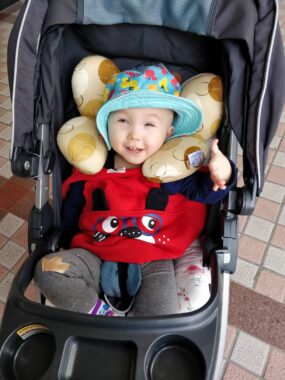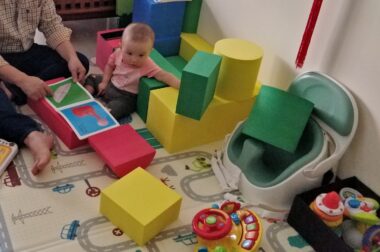How does dyskinesia relate to those who’ve had gene therapy?
In our case, it led fairly soon to voluntary movement, which was the goal
Written by |

Our daughter, Rylae-Ann, blinked her eyes a few times before scanning the white room. A warm smile instantly appeared when her hazel eyes fell on my wife, Judy. That’s how she began the first day of her new life.
In November 2019, Rylae-Ann underwent experimental gene therapy to treat her rare disease, aromatic l-amino acid decarboxylase (AADC) deficiency. We knew what to expect after surgery, based on what the medical team explained and the data we’d gleaned from published reports about children who underwent clinical trials.
The doctor told us to manage our expectations and cautioned us that the first actions we see may be involuntary movements known as dyskinesia. That condition is difficult to explain, but when you see it, you understand it.

Shortly after receiving gene therapy in November 2019, Rylae-Ann Poulin began to show involuntary movements known as dyskinesia. (Photo by Richard E. Poulin III)
Dyskinesia
Parkinson’s disease has many symptoms similar to those of AADC deficiency. According to our friends at Parkinson’s News Today, dyskinesia is an erratic and writhing movement that can happen in any of the body’s limbs or even face. The movements are involuntary and erratic.
Before surgery, we were nervous about the procedure and couldn’t even think about a time afterward. However, we were beyond excited that Rylae-Ann was going to have gene therapy, like a child the night before Christmas. Neither dyskinesia nor any other possible symptoms were at the forefront of our minds.
Dyskinesia kicks in
About two weeks after her surgery, we began to see signs of dyskinesia. Truthfully, I was happy to see them. It was the first sign of movement I’d seen from my daughter, except for the painful movements she made from oculogyric crises or dystonia.
If these involuntary movements were possible, I thought, then voluntary movements should be, too. The muscles and the nerve endings were still there. She just needed to give her body time to adjust.
Progress follows dyskinesia
After the dyskinesia started, so did the progress. She learned about her hands and face. She began to flail her arms around in an attempt to interact with toys for the first time. Most importantly, looks of inquiry and determination joined her movements.
We began intensive physical therapy, which happened every day for several weeks. Over time, dyskinesia began to fade away, and her voluntary movements took control.
It’s hard to say when dyskinesia went away because we were so focused on the results and never really cared about those early movements in the first place. Our daughter was alive and had an opportunity at a new life; that was more important.
Dyskinesia’s role in predicting progress
Once the jerky movements subsided and were replaced with steady, controlled movements, we no longer thought about dyskinesia until a comment appeared in an AADC deficiency parent group chat on WhatsApp.
A parent wondered if the duration of dyskinesia had any relation to the results of gene therapy. More specifically, were the results better the longer the dyskinesia? This question was interesting to us.
Our daughter’s dyskinesia symptoms didn’t last long, and her movement results since have been great. However, I didn’t want to dismiss the parent’s claim right away, and parents are an excellent source for interesting questions that only those close to the disease would ask.
What do the data say about dyskinesia in AADC patients?
A 2021 study published in Molecular Therapy and primarily out of Taiwan shared the findings of 26 children who underwent gene therapy. Most of them had mild to moderate dyskinesia, which is consistent with Rylae-Ann’s experience. The majority of the patients’ dyskinesia symptoms resolved in a few months.
Dyskinesia was the most reported symptom, and nearly all patients had it after gene therapy, the study found. The onset of dyskinesia was different for our daughter, however, and seemed to come soon after surgery before residing a few weeks later. For other children in the study, the dyskinesia began a few months after surgery.
One section in particular seems to dispel this myth. The study’s finding suggests that patients who received gene therapy later in life would have dyskinesia more severe than younger patients. Dyskinesia wasn’t related to dosage, but was most likely a result of hypersensitivity from the newly increased dopamine levels in the body.

Rylae-Ann’s parents surround her with toys to encourage her to make her first voluntary movements. (Photo by Richard E. Poulin III)
Correlation does not imply causation
It’d be worth investigating whether the speed at which dyskinesia manifests could predict gene therapy’s success. However, the adage that correlation doesn’t imply causation holds true. Just because two things may seem to be connected doesn’t necessarily mean that they’re related or that one causes another.
Parents’ combined questions and thinking could suggest valuable topics for any researchers. Asking questions and posing hypotheses can help future progress in fighting our rare disease. Yet we shouldn’t jump to conclusions. Many variables exist when thinking about results, and most importantly, each child is unique.
Note: AADC News is strictly a news and information website about the disease. It does not provide medical advice, diagnosis, or treatment. This content is not intended to be a substitute for professional medical advice, diagnosis, or treatment. Always seek the advice of your physician or other qualified health provider with any questions you may have regarding a medical condition. Never disregard professional medical advice or delay in seeking it because of something you have read on this website. The opinions expressed in this column are not those of AADC News or its parent company, Bionews, and are intended to spark discussion about issues pertaining to aromatic l-amino acid decarboxylase deficiency.






Leave a comment
Fill in the required fields to post. Your email address will not be published.